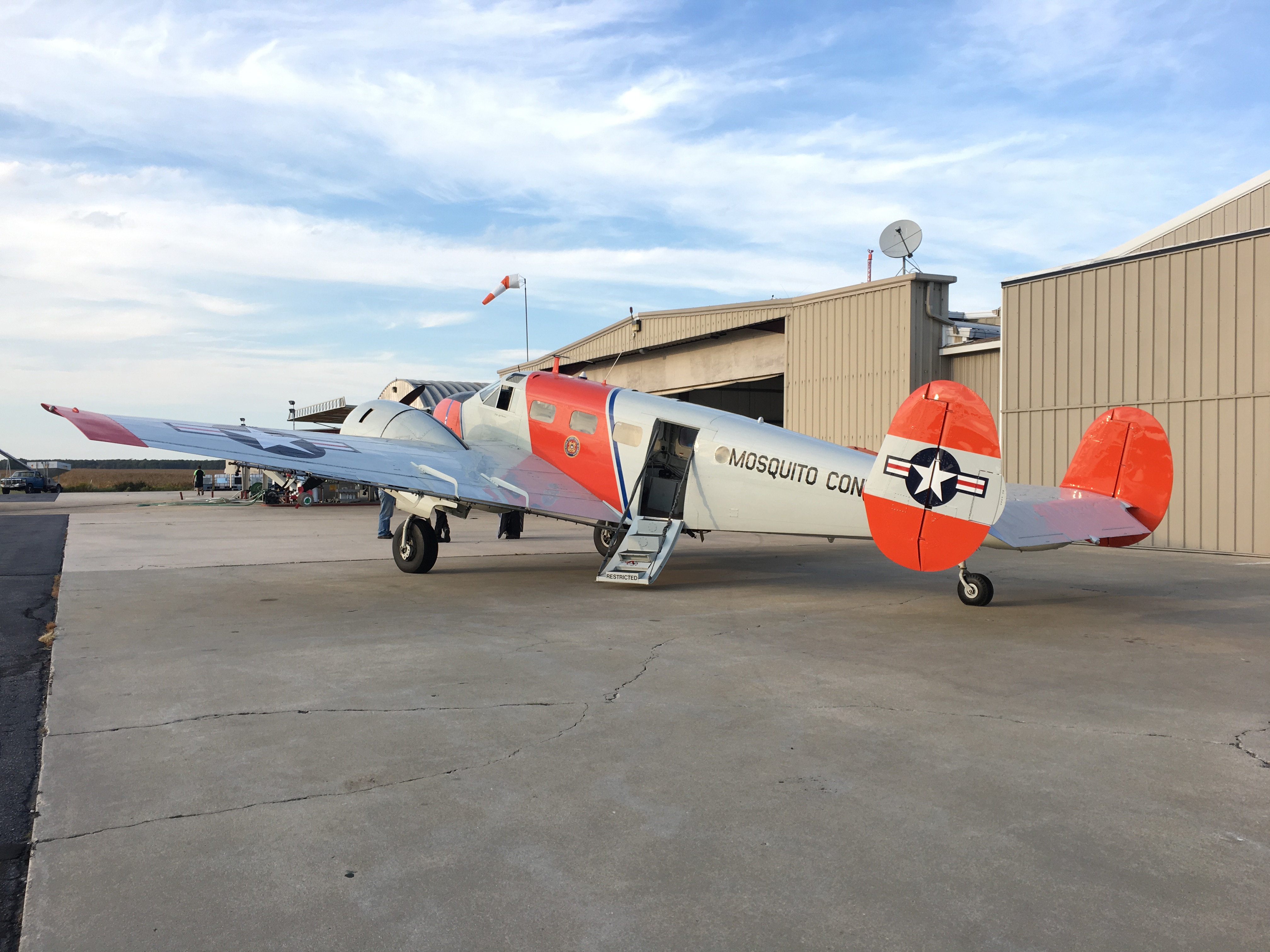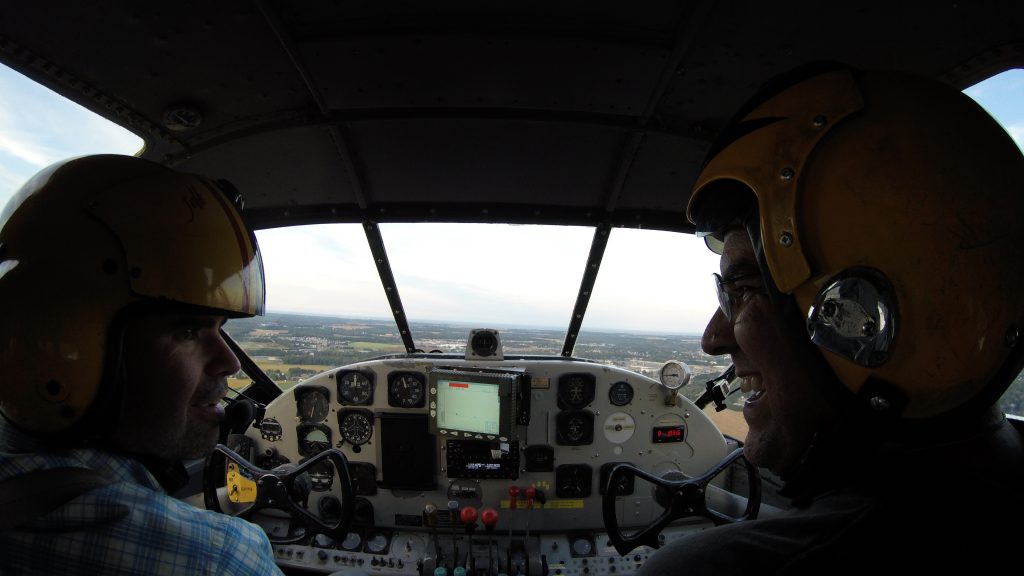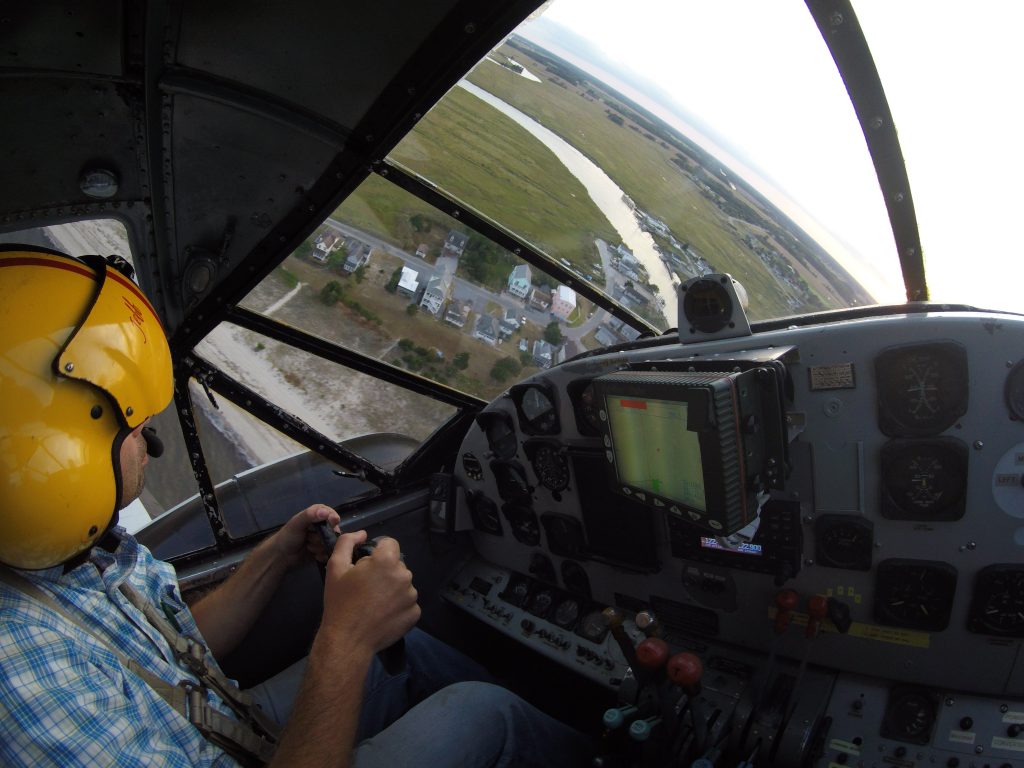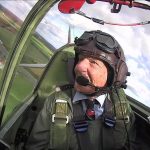On September 27, 2019, Warbird Digest was invited to fly with Allen Chorman & Son on a mosquito flight over the marshes of central Delaware. While en route to our target area, 41-year-old Jeff Chorman reminisced about how the 75-year-old JRB-4 that has been such an important part of not only his career, but his life.
By Stephen Chapis, Associate Editor
The Delmarva Peninsula, which is comprised of the states Delaware, Maryland, and Virginia, hence the abbreviation, is located in the Mid-Atlantic region of the United States. Bordered by the Chesapeake Bay to the west, the Delaware Bay and Atlantic Ocean to the east the peninsula is 170 miles long and varies in width from 70 miles across its central section to just a few thousand feet at its southern tip. The salt marshes, freshwater wetlands, wet woodlands, and roadside ditches of Delaware are the primary breeding grounds for mosquitoes. The agency responsible for controlling the mosquito population in Delaware is the Mosquito Control Section of the Department of Natural Resources and Environmental Control’s (DNREC) Division of Fish and Wildlife.
During the warmer months, Mosquito Control monitors and treats mosquito populations that emerge from wetland areas throughout the state, including ditches, stormwater ponds, wet woodlands, and coastal salt marshes. When relatively small areas, such as housing developments, truck-mounted “foggers” are used, while helicopters are used in small localized areas, but when whole towns or large rural areas require treatment fixed-wing ag aircraft are utilized. Since 1987, Allen Chorman & Son, Inc have operated a pair of Twin Beeches from their bucolic airport north of Greenwood, Delaware. Just before lunch on September 27, 2019, the author received a text from Jeff Chorman, “Would u want to ride in the twin this evening?” The response was obviously in the affirmative and Chorman said we would be wheels up out of Greenwood at 5:30 that evening.
The older of the pair is AT-11 USAAF #43-10384 (N4001A), which was delivered to the USAAF on February 29, 1943 and remained on active duty until January 1953. After operating as an aerial survey aircraft with Aero Service Corporation for nine years, Zero One Alpha was purchased by Chris D. Stoltzfus & Associates in March 1964 and converted into a mosquito sprayer. Delaware agricultural aviation pioneer Joseph R. Hudson, from whom Allen Chorman purchased the business from in 1987, purchased the aircraft on November 14, 1970 and immediately put it to work flying mosquito missions out of Eagle Crest-Hudson Airport (DE25), a grass strip north of Lewes, Delaware.
The aircraft we would be flying that warm early fall evening is the crown jewel of the Chorman fleet, JRB-4 BuNo 44633. Carrying registration N5552A since 1959, this aircraft was originally a C-45F that carried USAAF #44-87172 and was delivered to that service on May 15, 1945 but was transferred to the Navy two days later. After 14 years of service in the Navy and Coast Guard, the JRB was stricken in 1959. The aircraft was purchased by Chris D. Stoltzfus & Associates and converted to a spray aircraft just three months after Zero One Alpha. In the fall of 1975, after the loss of an AT-7 in a minor accident, Hudson purchased Triple Five Two Alpha and ever since it alighted at DE25 these Twin Beeches have shared the same hangar for the last 45 years.
Even though the setting sun was already touching the horizon, a pair of Chorman’s Ayres Thrushes were still hard a work. Even as Jeff pushed up the power, he was on the radio talking to one of the Thrush pilots, who was on the downwind, about the schedule for Sunday. The paved runway (16/34) at Chorman’s is 3,588 ft long but only 52 ft wide, which may seem narrow for a Twin Beech, but the 41-year-old Chorman has been flying this aircraft since he was a teenager and handles the aircraft with aplomb. As he raised the gear he made a gentle turn to the east-north-east and leveled off at 500ft for the 10-minute flight towards the Delaware Bay. We went “feet wet” just north of the small coastal community of Slaughter Beach and turned north toward our target area- a marshy area between the unincorporated community of Big Stone Beach and Bowers Beach, both of which are perched on the very edge of the Delaware Bay. As we roar over Big Stone Beach and the marshes north of the town Chorman watched the AG-NAV Guía GPS navigation system, a system designed and built for aerial application, and when the airplane shaped icon reached the edge of our target area, he flipped the switch on the yoke and the chemicals began streaming from the wingtips. Though we speed across the marsh at 100 feet AGL with a groundspeed of 160-mph Chorman appeared quite nonchalant, as if he were walking out to the mailbox. As we neared the end of our first pass, he pointed repeatedly towards the floor between us and said, “This is why I became an ag pilot. So, I could spray mosquitoes in Beech 18s.”
When the icon on the GPS reached the end of the designated area, Chorman flipped the switch to cut off the chemicals and executed a tear drop turn, never straying above 200 feet, to begin his next pass. For the next 40 minutes we made pass after pass, at literal treetop level, in the ever-darkening fall sky. All the while Chorman talked about his ag career, which began just after he graduated from high school, and reminisced about meeting Beech 18 pioneer Karl Stoltzfus, learning the ag business from Joe Hudson and his father Allen, as well as a few hangar stories about engine failures and the like.
At the end of the last pass, Chorman turned the controls over to the author for the flight back to Greenwood. He took a thumb drive out of his shirt pocket and plugged it into the GPS and started to download all the data from the flight and will be sent up to the Mosquito Control office. As we neared the airport it was almost completely dark, Chorman took a deep breath and spoke of the future, “Like anything, the time is coming that due to parts and maintenance and all that we’ll have to go to a King Air. I just don’t know when.” While the ubiquitous King Air would be a highly capable and efficient mosquito masher, but it lacks the nostalgic aura of the elder Beechcraft.


























